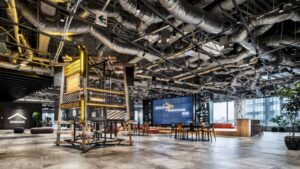As work evolves, it’s crucial to understand the new paradigms shaping our workplaces. Welcome back to our Unworking Weekly mini-series, inspired by new book Unworking: The Reinvention of the Modern Office by Philip Ross & Jeremy Myerson.
Over the past nine weeks, we have explored the themes of each chapter, offering insights into the book’s vision for the future of work and the workplace. Offices have been integral to society for the past century, influencing everything from city architecture to daily routines. However, the pandemic triggered a re-evaluation of the office’s role, promoting a shift away from outdated practices. As we enter the tenth week of our series, we explore Chapter 10, continuing our journey through the evolving landscape of work.
This week’s blog focuses on Chapter 10: Diversity. In today’s dynamic work environment, fostering diversity is not just a moral imperative but a strategic advantage. Diversity is now recognised as essential for driving creativity, innovation, and long-term success in organisations. This chapter investigates the complexities of diversity in the workplace, examining how different identities, experiences, and perspectives can be harnessed to create more inclusive and effective workplaces.
Diversity, in the context of work and workplace, refers to the wide array of differences among individuals within an organisation. This involves visible traits like race, gender, and age, as well as less visible aspects such as cultural background, sexual orientation, socio-economic status, and cognitive diversity. A truly diverse workplace goes beyond merely being representative; it actively cultivates an inclusive environment where every individual feels valued, respected, and empowered to contribute their best.
Diversity isn’t just about assembling a variety of individuals in the same space—it’s about leveraging these differences to enhance problem-solving, spark innovation, and foster a culture of collaboration and inclusion.
Leveraging Cognitive Diversity for Innovation
Cognitive diversity, or diversity of thought, emphasises the unique ways individuals think, solve problems, and generate ideas based on their varied experiences, backgrounds, and perspectives. In workplaces that actively promote cognitive diversity, teams benefit from a wider range of problem-solving strategies, which often leads to more creative, innovative outcomes.
This approach is especially crucial in fast-paced industries, where complex challenges require fresh, unconventional solutions to stay competitive. By fostering an environment where diverse perspectives can intersect, organisations can enhance their adaptability, drive innovation, and ultimately achieve better results.
Accenture, a global professional services firm, exemplifies the power of cognitive diversity across its entire workforce. The company integrates cognitive diversity into its operations through global initiatives, such as cross-functional team collaboration, innovation hubs, and a strong commitment to inclusion. This focus is not confined to any single office but is part of a broader global strategy. Notably, Accenture’s Innovation Hubs—located in key cities such as New York, San Francisco, Bangalore, and Dublin—serve as prime examples where cognitive diversity is central. These hubs bring together multidisciplinary teams from various regions and sectors to address complex problems, fostering innovation through a merging of diverse thought processes and perspectives. By embedding cognitive diversity into its global strategy, Accenture ensures that this practice enhances creativity and problem-solving across its operations.

Fostering an Inclusive Culture for Employee Well-Being
Diversity must go hand in hand with inclusion—ensuring that diverse employees not only have a seat at the table but also feel genuinely welcomed and supported. An inclusive culture promotes psychological safety, where employees can openly share their ideas and perspectives without fear of discrimination or dismissal. By creating an environment where every individual feels valued and heard, organisations build stronger, more cohesive teams. This inclusivity drives higher engagement and satisfaction, as employees are more motivated and committed when they feel truly accepted. Additionally, an inclusive workplace enhances overall performance and innovation, as diverse perspectives lead to richer problem-solving and more creative solutions. In essence, inclusivity transforms diversity from a mere metric into a powerful driver of organisational success.
Salesforce is a prime example of a company that exemplifies this approach. The company has established various programs, including Equality Groups, aimed at creating safe and supportive spaces for underrepresented groups. These initiatives, coupled with inclusive design features in their Salesforce Tower in San Francisco, are designed to ensure that employees from all backgrounds feel welcomed and valued. This supportive environment contributes to higher job satisfaction and greater engagement, ultimately enhancing overall well-being and performance. Salesforce’s commitment to integrating inclusion into their diversity efforts demonstrates how creating an inclusive culture can drive both individual and organisational success.

Designing Spaces for Diverse Workstyles
Another crucial aspect of fostering diversity in the workplace is recognising and accommodating the different work styles and preferences of employees. People vary greatly in how they approach their work; for example, introverts may prefer quiet, isolated spaces to focus deeply, while extroverts might thrive in lively, collaborative environments. Creating a workplace that caters to these diverse needs is essential for enhancing both productivity and employee satisfaction.
A thoughtfully designed office can balance these varying requirements by offering a variety of workspaces. This includes quiet zones for focused tasks, collaborative areas for team projects, and flexible spaces that can be adapted as needed. By catering to diverse work styles, organisations not only support individual preferences but also foster a more inclusive and efficient work environment.
Microsoft’s Redmond Campus exemplifies this approach to designing for diverse work styles. The campus features a range of workspaces, from open collaboration zones designed for team interaction and brainstorming to quiet focus rooms tailored for deep, individual work. Additionally, Microsoft has incorporated various flexible spaces that employees can adjust to fit their needs, ensuring that everyone—from those who thrive on social interaction to those who need solitude—can find an environment that supports their work style.
This diverse range of spaces at Microsoft’s campus is a testament to the company’s commitment to creating an inclusive work environment. By offering choices that align with different preferences and tasks, Microsoft helps its employees work more effectively and comfortably, ultimately contributing to overall job satisfaction and performance.

This discussion of Chapter 10: Diversity from Unworking: The Reinvention of the Modern Office highlights the importance of fostering diversity in today’s evolving workplace. From leveraging cognitive diversity to fostering an inclusive culture and designing spaces for different work styles, diversity is a critical component of modern office environments.
Readers can dive deeper into the exploration of diversity in the workplace and its impact on the future of work in Philip Ross and Jeremy Myerson’s latest book, Unworking: The Reinvention of the Modern Office. By understanding the power of diversity in all its forms, we can design workplaces that are not only more inclusive and innovative but also more responsive to the needs of today’s global workforce.
To dive deeper into the impact of space on workplace diveristy and discover more insights from Philip Ross and Jeremy Myerson’s Unworking, grab your copy from Amazon here.
